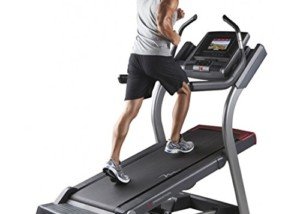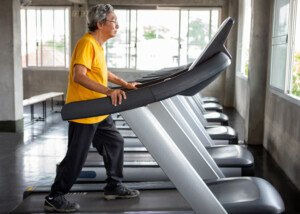One of the biggest exercise mistakes, if not THE biggest, is that of holding onto a treadmill – a very bad habit done by able-bodied men and women including those in their 20s.
It has always been vexing to me as to what it is about this piece of machinery that beckons adults of all ages, including lean and muscular, to hold on while doing the must fundamental of human movement: walking.
Most of us began walking by age one.
How is it that we, as adults who’ve been walking without assistance for decades, need to hold onto something to walk on a treadmill?
The irony is that some people believe that walking on a treadmill isn’t true exercise even if your arms are swinging freely, because – according to them — the moving tread “helps” your feet.
Yet at the same time, there are those who believe that a moving tread beneath their feet throws them off-balance and hence, they hold onto the bar, the rails or the console.
Walking on a Treadmill IS Real Exercise
If you’re not holding on, your body is forced to keep pace with a moving belt beneath your feet. This is true exercise.

Freepik.com, lyashenko
Is it identical to walking the same speed outside? No. But it still yields the same benefits as walking the same speed outside – as long as your hands are free.
The moment you hold on, your body “walks” below baseline. Think of the baseline as the walking you do around your house or inside your workplace.
Even if able-bodied people hold onto a treadmill at fast speeds and high inclines, this sabotages the objective.
Nobody who has the speed at 4 mph and incline at 15 mph, and who’s holding on, is using a light grip for a sustained walk. Nobody. I’ve observed enough people to know this.
• The faster the speed, the tighter the grip.
• The higher the incline, the tighter the grip.
• Often, such users tug forward with each step.
• This cheating removes significant workload from the core and lower extremities.
It’s just as defeating for an older, less-conditioned person to hold onto a treadmill as it is for a 25-year-old bodybuilder.
I’ve asked people of all ages and body types over the years why they hold on. Some answers were:
• Fear of falling off or losing one’s balance.
• Had no idea that holding on was a saboteur.
• “I can’t keep up if I let go.”
• “The rails are there and my hands just have a tendency to go there.”
• “As long as I get my heart rate up, I don’t care.”
• “My personal trainer said it’s okay.”
Look, it is wrong.
Fear of falling off, losing your balance or inability to keep up are all easily corrected by slowing the speed and/or reducing the incline.
Otherwise, you are training your body to be LESS efficient at balance and coordination.
A lot of core work is disconnected when you hold onto the treadmill.
The legs do much less work because the arms and hands are absorbing some workload.
The body learns to ambulate in an unnatural way that will not carry over to any lengthy walks you’ll need to do on your upcoming vacation.
Some Personal Trainers Are Lemons
Any personal trainer who endorses holding onto a treadmill is wrong. A personal trainer is supposed to empower the client, not enable them.
I once asked a personal trainer why, after working with a new 20-something female client for three weeks, he still had her holding onto the treadmill.
His exact words were: “She’s scared.”
How patronizing. Something tells me if the client were a man, the trainer would not have coddled him.
One of the ideas behind personal training is to help the novice embrace exercise.
Certainly, this doesn’t mean order her to attempt pull-ups on the first day of training.
But holding onto something WHEN WALKING? How enabling and insulting is THAT?
 Lorra Garrick is a former personal trainer certified through the American Council on Exercise. At Bally Total Fitness she trained women and men of all ages for fat loss, muscle building, fitness and improved health.
Lorra Garrick is a former personal trainer certified through the American Council on Exercise. At Bally Total Fitness she trained women and men of all ages for fat loss, muscle building, fitness and improved health.
.










































